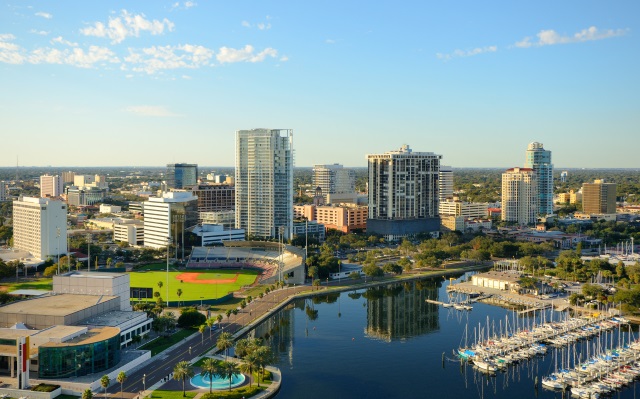St. Petersburg is located on the Pinellas peninsula between Tampa Bay and the Gulf of Mexico, and is connected to mainland Florida to the north. It is surrounded by 244 miles of shoreline along Tampa Bay, Boca Ciega Bay, the Gulf of Mexico. As of the 2015 census estimate, the population was 257,083, making it the fifth-most populous city in Florida.
With an average of some 361 days of sunshine each year, and a Guinness World Record for logging the most consecutive days of sunshine (768 days between 1967 and 1969), it is nicknamed "The Sunshine City". Due to its good weather and low cost of living, the city has long been a popular retirement destination, although in recent years the population has moved in a much more youthful direction. American Style magazine ranked St. Petersburg its top mid-size city in 2011, citing its "vibrant" arts scene.
St. Petersburg has the third-largest dedicated public waterfront park system in North America, with a waterfront park system that stretches 7 miles and is used year-round for public events, festivals and other activities.
St. Petersburg is home to more than 100 neighborhoods. In the eastern center of the city is Downtown St. Petersburg, which includes the city's residential and commercial skyscrapers, art galleries, museums, and parks. Apart from downtown's business and cultural aesthetics, the area also includes a branch of St. Petersburg College and the University of South Florida St. Petersburg, and is home to two professional sports teams, the Tampa Bay Rays and Tampa Bay Rowdies.
Historic Old Northeast and Snell Isle are north of Downtown. They both have Mediterranean style historic and waterfront homes, parks, and recreational areas. The western side of St. Petersburg includes the Grand Central District and Historic Kenwood. The Grand Central District houses the cities cafes, art galleries, restaurants, and bars all owing to the Renaissance style architecture. Historic Kenwood is filled with art studios and galleries similarly to the Grand Central District. Southward to St. Petersburg is Historic Roser Park, which houses Mediterranean style housing, parks, and museums.[93] The neighborhood is divided by Booker Creek which flows into Bayboro Harbor.
Approximately 2,300 acres of public land are dedicated to parks and recreation, including a seven mile preserved downtown waterfront -- the third largest urban waterfront park system in North America. Unique parks include the 245-acre Boyd Hill Nature Preserve, the botanical attraction Sunken Gardens, Treasure Island Beach on the Gulf of Mexico, and the historic Weedon Island Preserve. The Pinellas Trail, a 37-mile hiking/biking trail, connects St. Petersburg with central and north Pinellas County-the longest urban linear trail in the Eastern U.S.
The Pinellas County School System serves St. Petersburg, the 7th largest district in Florida and 22nd largest in the nation. More than 148,000 students are enrolled at 140 public schools, 72 private schools and 5 vocational/technical schools. Universities include St Petersburg College, Eckerd College, University of South Florida St. Petersburg, Pinellas Technical Education Center, and Stetson University College of Law.








